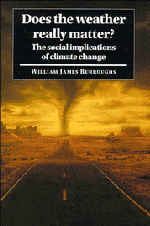1 - Introduction
Published online by Cambridge University Press: 26 February 2010
Summary
‘Why, sometimes I've believed as many as six impossible things before breakfast.’
The White Queen, in Through the Looking-Glass, Chapter 5
Dotted around the world are many examples of abandoned cities, monuments and settlements which appear to provide stark evidence of the part fluctuations in the climate can play in human activities. From the jungles of Guatemala to the shores of western Greenland fjords there are the ruins of societies which seem to have been overwhelmed by the effects of prolonged adverse weather. The same story of changing patterns of temperature or rainfall overwhelming day-to-day life can be seen in the Scottish uplands or the deserts of Arizona. The remains of past thriving communities appear to provide mute testimony to the part sustained changes in the weather have played in history.
At a time of growing concern about the impact of human activities on the climate these stark reminders of the impact of natural changes in the climate are seen as potent warnings. But are they relevant? The important questions are ‘How big a part did climate change play in both success and failure?’ and ‘Is the evidence of the past relevant to analysing current events?’ Only by addressing these questions can we decide whether examples from the past can be applied to current efforts to predict the consequences of future climatic change.
This process is not easy. The subject of the historical impact of climatic change stirs strong emotions. There is a range between those who argue that fluctuations in the climate were wholly inconsequential in the course of history to those who believe they are an unrecognised mainspring which has controlled the outcome of many events.
- Type
- Chapter
- Information
- Does the Weather Really Matter?The Social Implications of Climate Change, pp. 1 - 15Publisher: Cambridge University PressPrint publication year: 1997



